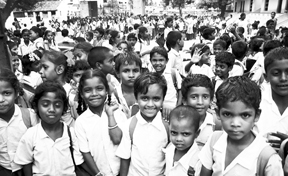The share of girls in the total enrolment at primary and upper primary level was 19% and 46.5% respectively in the year 2005-06; this increased to 48.5 and 48.1 at primary and upper primary levels respectively in 2009-10.
It is today’s children who will be the leaders of the nation in future.” The time-tested axiom need not be repeated. But how many of us pause to think over the lot of the children. Latest report of children in India titled Children in India 2012: A Statistical Appraisal by the Ministry of Statistics and Programme Implementation brings to us the progress we have achieved in terms of moulding the kids into healthy, educated, skilled, trained and, responsible citizens of tomorrow.
* The population of the country rose by 181 million during the decade 2001-2011. But there was a reduction of 5.05 millions in the population of children aged 0-6 years during this period. The decline in male children is 2.06 million and in female children is 2.99 millions.
* The share of Children (0-6 years) in the total population has showed a decline of 2.8 points in 2011, compared to Census 2001 and the decline was sharper for female children than male children in the age group 0-6 years.
* The overall sex ratio of the Country is showing a trend of improvement, whereas the child sex ratio is showing a declining trend. During the period 1991 -2011, child sex ratio declined from 945 to 914, whereas the overall sex ratio showed an improvement from 927 to 940. As per Census 2011, the State/ UTs with alarmingly low (i.e., less than 900) child sex ratio are, Haryana (830), Punjab (846), Jammu and Kashmir (859), Delhi (866), Chandigarh (867), Rajasthan (883), Maharashtra (883), Uttrakhand (886), Gujarat (886), Uttar Pradesh (899). The State/ UTs which are having better (i.e., more than 950) child sex ratio are Mizoram, (971), Meghalaya (970), A andN Islands (966), Puducherry (965), Chattisgarh (964), Arunachal Pradesh (960), Kerala (959), Assam (957), Tripura (953), West Bengal (950).
* The State/ UTs which have achieved 100% level of birth registration in 2007 are Arunachal Pradesh, Himachal Pradesh, Kerala, Meghalaya, Mizoram, Nagaland, Punjab, Tamil Nadu, Chandigarh, Lakshadweep and Puducherry.
* As per Coverage Evaluation Survey, 2009, at national level, 61% of the children aged 12-23 months have received full immunization. The coverage of immunization was higher in urban areas (67.4%) compared to that in the rural areas (58.5%).
* In 2010, IMR is reported to be 47 at the national level, and varies from 51 in rural areas to 31 in urban areas.
* The NFHS 3 (2005-06) results indicate that malnutrition is more prevalent among children in the higher birth order category. The rural India is witnessing more malnutrition among children 5+ years as higher percentage of stunted, wasted and underweight children were reported from rural areas.
* High malnutrition of all types prevails in the group of illiterate mothers and mother’s with less than 5 year’s education.
* Gross Enrolment Ratio (GER) at primary level is high at 115%, and Net Enrolment Ratio (NER) has improved significantly from 84.5% in 2005- 06 to 98% in 2009-10. High GER at primary level, however, indicates the presence of over-age and under age children, possibly due to early and late enrolment or repetition. During this period, Net enrolment ratio (NER) at Primary level has shown improvement in most of the State / UTs of the country.
* The share of girls in the total enrolment at primary and upper primary level was 19% and 46.5% respectively in the year 2005-06; this increased to 48.5 and 48.1 at primary and upper primary levels respectively in 2009-10.
* The major occupations engaging child labour are Pan, Bidi and Cigarettes (21%), Construction (17%), Domestic workers (15%) and Spinning and weaving (11%). As per census 2001, Uttar Pradesh (15.22%) recorded the highest share of child labour in the country, followed by Andra Pradesh (10.76%), Rajasthan (9.97%), Bihar (8.82%), Madhya Pradesh (8.41%), and West Bengal (6.77%).
* It is alarming that, in 2011, the Crimes against children reported a 24% increase from the previous year with a total of 33,098 cases of crimes against Children reported in the country during 2011 as compared to 26,694 cases during 2010. The State of Uttar Pradesh accounted for 16.6% of total crimes against children at national level in 2011, followed by Madhya Pradesh (13.2%), Delhi (12.8%), Maharashtra (10.2%), Bihar (6.7%) and Andra Pradesh (6.7%).
* A total of 113 cases under prohibition of Child Marriage Act 2006 were reported in the country out of which highest were reported in West Bengal (25), followed by Maharashtra(19), Andhra Pradesh(15), Gujarat(13) and Karnataka(12). Considering all the Crimes against children, the Crime rate (ratio of number of crimes to population) has marginally increased from 2.3 in 2009 to 2.7 in 2011.
* The Conviction rate at national level for the crimes committed against children stood at 34.6%. The conviction rate for ‘infanticide (other than murder)’ was highest at 46.9% followed by cases under ‘murder’ (45.5%).
The Conviction rate at national level for the crimes committed against children stood at 34.6%. The conviction rate for ‘infanticide (other than murder)’ was highest at 46.9% followed by cases under ‘murder’ (45.5%).
(For detailed report log on to: http://mospi.nic.in/Mospi_New/upload/Children_in_India_2012.pdf)

COMMENTS